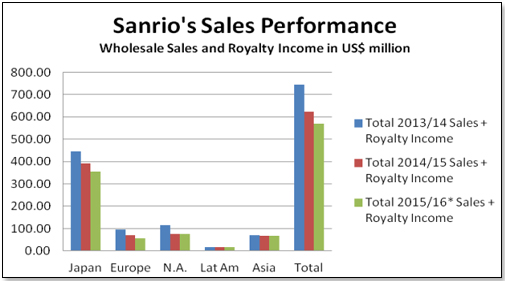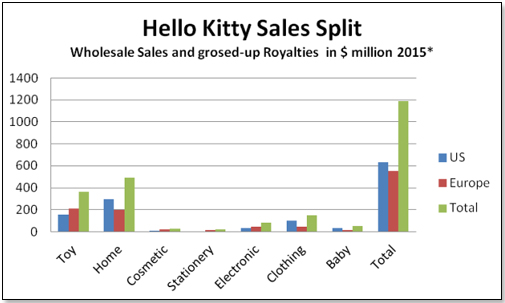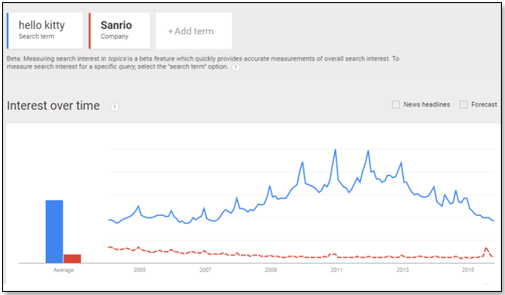 |

Tools:








Hello Kitty – a cat on life support?Can Sanrio maintain their success?
Hello Kitty has been a doll icon for the past forty years but her reign may slowly come to an end unless some fearless knight comes riding to her rescue.
First about Sanrio, the makers of Hello Kitty. The company was founded nearly forty years ago in Japan and now has sales plus royalty income in the neighborhood of slightly above US$ 500 million. If you assume that royalty income represents 10% of licensee sales, you are looking at a much bigger US$ 2.9 billion total sales. Their sales have been declining for three years in succession. This point is also reflected in their share price performance on the Tokyo stock exchange:

This is how their numbers break out – first as reported by the company, and then showing total sales with license sales grossed up to represent wholesale values at an assumed royalty rate of 10%:

and

You will immediately notice two things- one is that Japan is today by far the largest market and secondly that the company had declining sales overall over the past three years.
In fact, Sanrio's sales picture is a little misleading in that you really look at two different businesses – one is Japan and Asia on one hand, and Europe and the Americas on the other.
The Asia business is heavily dependent on tourism - theme parks, duty free stores, city-centre stores, and shop-in-shops in department stores. Sanrio is also targeting the older age groups in other ways – selling jewelery, cosmetics, and other adult focused products.
Sanrio has now three theme parks – Sanrio Puroland, an indoor theme park opened in Tokyo in 1990; Sanrio Park Hamonyland on Kyushu Island in 1991; and the Hello Kitty theme park opened in July this year in Anji, Zhejiang Province, in China – 150 miles from Shanghai.
As the sales numbers above demonstrate, this strategy has not proven to be particularly successful and its extension into China this year does not look too promising either. A feature on English language website Smartshangai.com criticizes the theme park, with blogger Ian Louisell, describing it as having "inconsistent branding, mediocre rides, and some of the most wretched food I've encountered in seven years in China".
The Daily Mail UK added to this on February 11, 2015, that the park was 'Cheesy, boring and a mess: China's new £210 million (US$320 million) Hello Kitty theme park lambasted by fans; Food described as 'worse than any train food, but five times as expensive'; Rides called 'boring' and 'mediocre". There was also a positive review by a visitor to the park who wrote on September 29 that "the park was nearly empty during our visit which allowed us doing two or three times each activities without any queuing. The park isn't very big. I would say around 10 activities. Very clean. A couple of restaurants inside the park (serve only chinese food). Our girls enjoyed a lot their day in Hello Kitty Park. We'll probably do again."
What is generally not mentioned is that a very significant percentage of the visitors to this Hello Kitty park come from Shanghai – the locale for the Disneyland Park to be opened next year. There will undoubtedly be some erosion in visitor numbers once Disney gets going.
In contrast to their Asian business, Sanrio's business in the Americas and Europe is virtually exclusively focused on selling products carrying Sanrio's most popular brand, Hello Kitty, a toy icon first created in 1976. This is what it looks like:

The brand is extremely dependent on a host of small licensee companies. There are 15 in the United States, and about 60 throughout Europe. In addition, Sanrio has its own distribution companies in the U.S., U.K., Italy and Germany. Thereby lies the first problem – if you back out the sales made by the Sanrio companies, the average yearly sales volume per licensee is less than $1 million.
The brand is also at home in a vast variety of product categories which further dilutes the sales impact. This is how category sales break down in 2015:

Because the company relies on its licensees to promote the brand, and since these licensees do not have the sales volume to finance the necessary effort, the Hello Kitty brand is not supported to any great extent and very heavily relies on its aging existing consumer group to keep it alive. Sanrio executives said recently that they took the long view with their star attraction. Instead of pouring money into advertising, they relied on word-of-mouth publicity and giving merchandise to big-wattage stars.
In fact, I spoke to a few of these small licensees and they told me that Sanrio was only interested in four things during license negotiations – what percentage, what minimum sales levels, how much upfront payment and how long the license period. The small matters of brand execution, product innovation, advertising spending and in-store support were only mentioned as afterthoughts.
Because of all this – small vendors, no advertising budgets, highly fragmented offering – the brand for all its overall sales volume is very much a non-entity as far as the major retailers are concerned. This has negative consequences on shelf space, shelf location, inventory commitment – all of which diminishes the strength of the brand.
It hence comes as no surprise that Hello Kitty sales are going South pretty much in line with that of Sanrio's overall decline – not only in Europe and the U.S. but also in Sanrio's backyard Japan and China. There are two more markers that suggest that there is declining consumer interest in the brand. One is the impact Hello Kitty is making on social media:

Source: Tickertags.com
In fact, Google Trends shows an even more extreme picture as to Hello Kitty's web traffic:

There is also the matter of Hello Kitty's rate of preference amongst Japanese consumers. Sanrio has run a popularity poll for its characters each year since 1984 in which voters can nominate their favorite Sanrio character. This year, 3,765,250 votes were cast. Traditionally, Hello Kitty walked away with the #1 spot – except in 2014 when it was relegated to the second spot and then again this year when it clocked in as #7.
Unfortunately, rather than trying to address the very clear problems Hello Kitty has as a consumer brand, Sanrio continues to charge happily ahead with its policy of spending money on ventures that have been shown up as failures elsewhere. This is clearly demonstrated by three steps:
· They opened Europe's first permanent Hello Kitty attraction at Drusilla's Park in the UK in May last year. .
· On June 8 this year, they announced a partnership with Universal Parks and Resorts to develop interactive Sanrio retail shops at Universal Orlando and Universal Studios Hollywood.
· And finally Sanrio on July 3 announced plans to develop a Hello Kitty film for global release in 2019 at an estimated cost of US$ 200 million.
History is replete with examples of toy marketers bent on milking their core brands to finance ill-advised diversification ventures. Apple in the eighties, Mattel with Barbie in the nineties and Lego at the turn of the century come to mind. In all three cases, the companies got smart in the nick of time – they recognized that they were pursuing bad strategies, they got in new people, and they decided to stick to their knitting. In other words, they began to refocus on their core business that had made them great in the first place. Time will tell whether this will also be the case with Sanrio.
So, where is that fearless knight when Hello Kitty really needs one?
 Writer's Bio: Writer's Bio: Lutz Muller is a Swiss who has lived on five continents. In the United States, he was the CEO for four manufacturing companies, including two in the toy industry. Since 2002, he has provided competitive intelligence on the toy and video game market to manufacturers and financial institutions coast-to-coast. He gets his information from his retailer panel, from big-box buyers and his many friends in the industry. If anything happens, he is usually the first to know. Read more on his website at www.klosterstrading.com. Read more articles by this author
THIS BANNER IS AN AD:

Back to TDmonthly's front page
|  |
Advertise on TDmonthly

|


